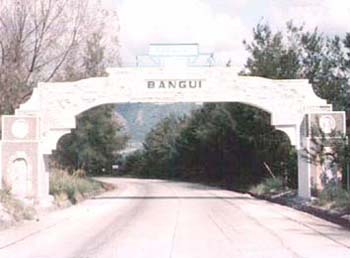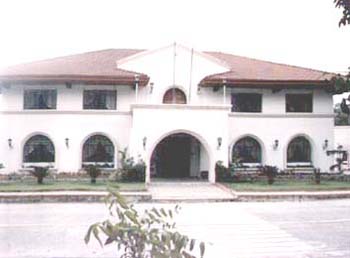

| Municipality of BANGUI |

Born in 1786, 265 years after Fernando Magallanes set foot on the solid of the Orient Pearl; the biggest geographical area at the time, north of the provincial capital of Laoag City, is ancient Bangui; then embracing the towns of Burgos and Pagudpud, Ilocos Norte, up north, to include the municipality of Sta. Praxedes, province of Cagayan. Although the boundary of the municipality of Bangui towards the southwest extends to the flatlands of Burgos, one does not readily notice the difference in the delineation until one reaches the Baruyen zigzag road, and from this vantage point when one looks down if he comes from the south, his gaze is met by a postcard view of the sprawling town of Bangui reamed a long the northwest by beautiful Bangui Bay and to the east and southeast by verdant mountains and hills from whose foot spread the fertile valleys, criss-crossed by rivers and brooks which flow towards the sea. This panorama therefor is therefore is the beacon that invites one to get more interest in this town. Indeed, one finds that Bangui has fifteen barangays, namely: San Lorenzo, Nagbalagan, Abaca, Masikil, Banban, Baruyen, San Isideo, Malasin, Taguiporo, Payac Manayon, Utol, Bacsil, Dadaor, and Lanao - a few year back was chosen as the most outstanding and model barangay of the Philippines, during the time of the late Mayor Alfredo A. Garvida by PACD-SEATO sponsored village contest. The main occupation of the people is farming, producing rice as staple food for its industrious people; cash crops like garlic, tobacco, root crops, a variety of fruits and vegetables. Its rivers and brooks teem with fish the whole year round and along sea cost, fishing comes handy to provide for delectable sea foods. One will also find that there are schools in every barangay. Then comes the secondary schools, Bangui High, St. Larence Academy and Banban Barangay High School, and the recently established School of Fisheries - institutions of learning which have spawned lawyers, doctors, engineers, nurses, teachers, soldiers, and hundreds of other professionals, some having attained already degrees of affluence and prestige, bringing accolades to this town.
But Bangui is like a gem for there is much more to its existence than the Baruyen Zigzag Road, God had been generous in bestowing upon its face some natural scenic spots for all to behold. There is the Sentinela Hill standing proudly as its name connotes, right in the middle of the town where one would get a commanding view of nearby Pagudpud, a glimpse of the hills of Burgos to the south and on the north, the Bangui coastline. At nearby Barangay San Isidro is the Bolo River Irrigation Dam buttressed on both sides at the river bend by the picturesque mountainsides. Aside from watering a wide expanse of rice fields, at the bend the mighty Bolo River is tapped, is a natural pool where one could get a cool and refreshing dip on summertime. Located along the mountainsides that frames Barangay Lanao to the southwest is the Abang Falls, whose veil-like dropping waters cascades down in poetic fashion over boulders and stones. The pool on its second tier is ensconced by the deep mountain gorge that shelters a variety of air plants. Bangui coastline is ideal for promenading, what with its stretch of fine sands, and only a stone's throw from the poblacion. These and more, Bangui can offer to all good and sundry. But beyond all these natural endowment, Bangui stands as a typical Ilocano town whose people pulsate with warmth, gaiety and sincerity. |






